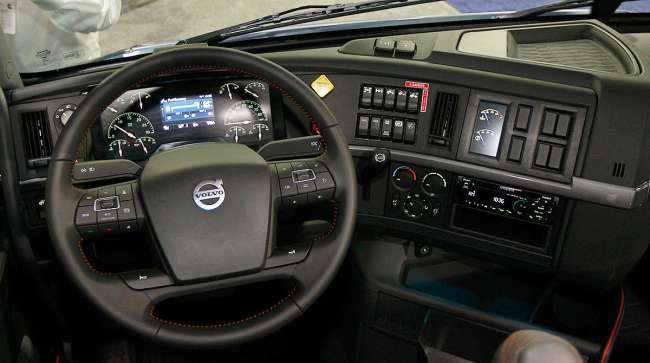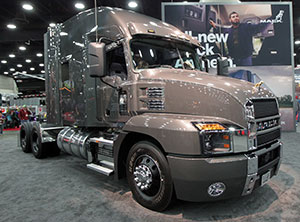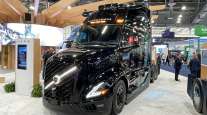Senior Reporter
AB Volvo Posts Record Third Quarter, Higher Income and Revenue

AB Volvo notched a 38% gain in net income as record third-quarter revenue was lifted by stronger truck orders and deliveries.
The earnings announcement landed shortly after Volvo reported an emissions-control component on trucks used primarily in North America and Europe is degrading more quickly than expected and could cause the engines to exceed emissions limits for nitrogen oxides.

Lundstedt
Meanwhile, for the period ended Sept. 30, Volvo — which reports in Swedish krona — earned the equivalent of $830 million, or 41 cents a share, on global revenue of $10.25 billion. In the 2017 third quarter, the company had net income of $600 million, or 30 cents, on sales of $8.48 billion.
Volvo, the world’s second-largest truck maker, saw its operating margin climb to 11.1% compared with 9.6% a year earlier.
“Although this is the best third quarter ever for the group, it does not mean that we have reached our full potential. There is more to do to improve profitability and drive cash flow,” Volvo CEO Martin Lundstedt said in a statement.
“A key area is to grow our service business, and our work to increase service contract penetration, workshop performance and service capacity is yielding good results,” he said.
At the same time, globally, truck orders increased 26% to 65,348. That came despite a 36% decline in Asia to 6,111 orders and single-digit growth in Europe.
North American order intake increased by 116% to 26,085 vehicles and deliveries increased by 39% to 13,565 vehicles — propelled by the region’s strong economy, truck capacity issues and high freight rates.
Volvo Trucks saw its Class 8 North American retail sales market share, boosted by new models, climb to 10.5%, up from 8.6% a year earlier.

Mack Anthem. (John Sommers II for Transport Topics)
On the other hand, Mack Trucks was hampered by supply constraints following the transition into its new Anthem model during the spring, which is why Mack’s heavy-duty market share declined to 6.6% from 7.7% a year earlier, according to the Gothenburg, Sweden-based company.
Mack’s orders in the quarter climbed 17% to 7,919 compared with 6,763 in the 2017 quarter. Mack’s deliveries increased 19% to 6,076 compared with 5,100 a year earlier.
The parent company maintained its industrywide forecast for Class 8 North American production to reach 300,000 this year, and 310,000 for 2019. With the ongoing strong demand, supply chain constraints in North America are expected to remain in the near-term.
Volvo highlighted a pair of developments during the quarter that it viewed as significant.

Volvo's Vera. (Volvo Truck Corp.)
On Sept. 12, Volvo Trucks unveiled Vera, a battery-electric alternative to a tractor that is wirelessly connected to a transport control center as it moves trailers in ports, factory areas and large logistics centers where high volume loads are highly repetitive and cover short distances — but additional uses are possible. Vera is currently being developed with customers.
On Sept. 27 the California Air Resources Board preliminarily awarded $44.8 million to California’s South Coast Air Quality Management District for the Volvo LIGHTS (Low Impact Green Heavy Transport Solutions) project. If the project is launched, Volvo Trucks plans to introduce all-electric truck demonstrators in California next year, and commercialize them in North America in 2020.
In the meantime, Lundstedt said Volvo was not talking about an immediate recall of its trucks affected by the emission issue.
Instead, the degradation of the affected part will occur over the lifetime of a vehicle, he said.
At delivery, all engines and vehicles equipped with the suspect component — which was not identified — meet emissions limits, according to the company.
The U.S. Environmental Protection Agency is discussing the situation with Volvo, Bloomberg News reported.
“We are evaluating the magnitude of that population. We are not worried about fines. We have proactively informed the authorities about this. We will address the cost once we have defined the population,” Lundstedt said during an interview with Bloomberg.
Volvo in announcing the issue said “the cost could be material.”
In related news, engine maker Cummins Inc. has begun a separate voluntary recall of 500,000 model-year 2010-15 medium- and heavy-duty trucks with its engines to replace a defective catalyst in the emissions control system.
Cummins has set aside $181 million to cover the related costs.
The Cummins campaign is the largest voluntary recall of medium- and heavy-duty trucks, according to the EPA.
“It is going according to plan, we have started notifying customers and repairing affected engines,” Cummins spokeswoman Katie Zarich told Transport Topics on Oct. 19.




